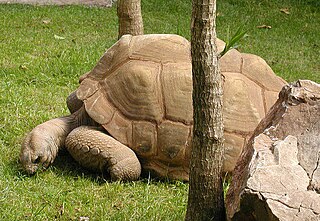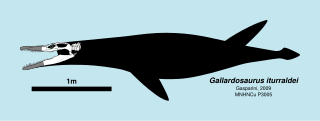
Chelidae is one of three living families of the turtle suborder Pleurodira, and are commonly called Austro-South American side-neck turtles. The family is distributed in Australia, New Guinea, parts of Indonesia, and throughout most of South America. It is a large family of turtles with a significant fossil history dating back to the Cretaceous. The family is entirely Gondwanan in origin, with no members found outside Gondwana, either in the present day or as a fossil.

Podocnemididae is a family of pleurodire (side-necked) turtles, once widely distributed. Most of its 20 genera and 30 species are now extinct. Seven of its eight surviving species are native to South America: the genus Peltocephalus, with only one species ; and the genus Podocnemis, with six living species of South American side-necked river turtles. There is also one genus native to Madagascar: Erymnochelys, the Madagascan big-headed turtle, whose single species E. madagascariensis.
In the geological timescale, the Tithonian is the latest age of the Late Jurassic Epoch and the uppermost stage of the Upper Jurassic Series. It spans the time between 149.2 ±0.7 Ma and 145.0 ± 4 Ma. It is preceded by the Kimmeridgian and followed by the Berriasian.

The Cryptodira are a suborder of Testudines that includes most living tortoises and turtles. Cryptodira differ from Pleurodira in that they lower their necks and pull the heads straight back into the shells, instead of folding their necks sideways along the body under the shells' marginals. They include among their species freshwater turtles, snapping turtles, tortoises, softshell turtles, and sea turtles.

Machimosaurus is an extinct genus of machimosaurid crocodyliform from the Late Jurassic and Early Cretaceous. The type species, Machimosaurus hugii, was found in Switzerland. Other fossils have been found in England, France, Germany, Portugal, Switzerland and Tunisia. Machimosaurus rex is the largest named teleosauroid and thalattosuchian, with an estimated length of up to 7.15 m (23.5 ft). Machimosaurus is the largest known crocodyliform of the Jurassic.

Geosaurus is an extinct genus of marine crocodyliform within the family Metriorhynchidae, that lived during the Late Jurassic and the Early Cretaceous. Geosaurus was a carnivore that spent much, if not all, its life out at sea. No Geosaurus eggs or nests have been discovered, so little is known of the reptile's lifecycle, unlike other large marine reptiles of the Mesozoic, such as plesiosaurs or ichthyosaurs which are known to give birth to live young out at sea. Where Geosaurus mated, whether on land or at sea, is currently unknown. The name Geosaurus means "Mother of Giants lizard", and is derived from the Greek Ge- and σαῦρος -sauros ("lizard"). The name Geosaurus was established by the French naturalist Georges Cuvier in 1824.

Stupendemys is an extinct genus of freshwater side-necked turtle, belonging to the family Podocnemididae. It is the largest freshwater turtle known to have existed, with a carapace over 2 meters long. Its fossils have been found in northern South America, in rocks dating from the Middle Miocene to the very start of the Pliocene, about 13 to 5 million years ago. Male specimens are known to have possessed bony horns growing from the front edges of the shell and the discovery of the fossil of a young adult shows that the carapace of these turtles flattens with age. A fossil skull described in 2021 indicates that Stupendemys was a generalist feeder.

The Pleurodira are one of the two living suborders of turtles, the other being the Cryptodira. The division between these two suborders represents a very deep evolutionary divide between two very different types of turtles. The physical differences between them, although anatomical and largely internal, are nonetheless significant, and the zoogeographic implications of them are substantial. The Pleurodira are known more commonly as the side-necked turtles and the name Pleurodira quite literally translates to side neck, whereas the Cryptodira are known as hidden-necked turtles. The Pleurodira turtles are currently restricted to freshwater habitats in the Southern Hemisphere, largely to Australia, South America, and Africa. Within the Pleurodira, three living families are represented: Chelidae, also known as the Austro-South American side-necked turtles, the Pelomedusidae, also known as the African mud terrapins, and the Podocnemididae, also known as the American side-neck river turtles. However, they were cosmopolitan clade during the Cretaceous and most of the Cenozoic, and even occurred in marine environments around the world.

Bothremydidae is an extinct family of side-necked turtles (Pleurodira) known from the Cretaceous and Cenozoic. They are closely related to Podocnemididae, and are amongst the most widely distributed pleurodire groups, with their fossils having been found in Africa, India, the Middle East, Europe, North America and South America. Bothremydids were aquatic turtles with a high morphological diversity, indicative of generalist, molluscivorous, piscivorous and possibly herbivorous grazing diets, with some probably capable of suction feeding. Unlike modern pleurodires, which are exclusively freshwater, bothremydids inhabited freshwater, marine and coastal environments. Their marine habits allowed bothremydids to disperse across oceanic barriers into Europe and North America during the early Late Cretaceous (Cenomanian). The youngest records of the group are indeterminate remains from Saudi Arabia and Oman, dating to the Miocene.
Cricosaurus is an extinct genus of marine crocodyliforms of the Late Jurassic. belonging to the family Metriorhynchidae. The genus was established by Johann Andreas Wagner in 1858 for three skulls from the Tithonian of Germany. The name Cricosaurus means "Ring lizard", and is derived from the Greek Krikos- ("ring") and σαῦρος -sauros ("lizard"). It was a relatively small reptile, with C. suevicus and C. araucanensis measuring 2 m (6.6 ft) and 3.2 m (10 ft) in total body length, respectively.

Gallardosaurus is a genus of pliosaurid plesiosaur from the Caribbean seaway. It contains the single species Gallardosaurus iturraldei. Gallardosaurus was found in middle-late Oxfordian-age rocks of the Jagua Formation of western Cuba. Gallardosaurus is believed to be evolutionarily connected to Peloneustes, a pliosaurid commonly found in the Oxfordian-aged sediment.
Notoemys is an extinct genus of platychelyid turtle known from the Late Jurassic and Early Cretaceous of the Americas.
The Reuchenette Formation is a Jurassic geologic formation in Switzerland. It is Kimmeridgian in age and predominantly consists of well stratified limestone, with lithology variable both laterally and stratigraphically including wackestones, packstones and grainstones, as well as mudstone. Dinosaur remains are among the fossils that have been recovered from the formation, including the Turiasaurian sauropod Amanzia greppini, alongside a theropod tooth belonging to Ceratosauria indet, originally assigned to Megalosaurus meriani. teleosaurid crocodyliformes are also known, including Sericodon, Proexochokefalos and Machimosaurus. The thalassochelydian turtle Solnhofia is known from the formation, as is the platychelyid turtle Platychelys.
The Jagua Formation is a Late Jurassic geologic formation in the Sierra de los Órganos and Sierra del Rosario mountain ranges in Pinar del Río Province, western Cuba. Plesiosaur, pliosaur, pterosaur, metriorhynchid, turtle and dinosaur remains are among the fossils that have been recovered from its strata.

Pleurosternon is an extinct genus of freshwater pleurosternid turtle from the latest Jurassic to earliest Cretaceous of Europe. Its type species, P. bullockii was described by the paleontologist Richard Owen in 1853. Since then, and throughout the late 19th century, many fossil turtles were incorrectly assigned to this genus, though only two are currently considered valid.

Pleurosternidae is an extinct family of freshwater turtles belonging to Paracryptodira. They are definitively known from the Late Jurassic to Early Cretaceous (Albian) of Western Europe and North America.

Solnhofia is a genus of extinct thalassochelydian turtle from the Late Jurassic of Germany. The type species is Solnhofia parsonsi, named by Gaffney in 1975 for a partial skull and jaw from the early Tithonian of the Solnhofen Formation in Bavaria. Additional material including a complete skeleton is known from the late Kimmeridgian of Switzerland and the Kimmeridgian/Tithonian of other deposits within Bavaria, and potentially also unprepared material from the Late Jurassic of France. The genus was referred to the family Eurysternidae by Anquetin and colleagues in 2017, which may represent an artificial grade of early thalassochelydians. In 2020 a new species Solnhofia brachyrhyncha was described from the Kimmeridigan aged Reuchenette Formation of Switzerland.

Coccolepididae is an extinct family of ray-finned fish, known from the Early Jurassic to Early Cretaceous, most of which were originally referred to the type genus Coccolepis. They had a widespread distribution, being found in North and South America, Australia, Asia and Europe. They are mostly known from freshwater environments, though several species have been found in marine environments. They are morphologically conservative, and have poorly ossified endo and exoskeletons, which usually results in poor preservation. This makes it difficult to distinguish species. They are generally small fish, with the largest known specimens reaching a length of 210 mm. Historically, they have been classified as members of “Palaeonisciformes”, a paraphyletic grouping of non-neopterygian fish, due to their plesiomorphic conservative morphology closely resembling those of many other groups of primitive fish. They have been suggested to be relatives of the Acipenseriformes within the Chondrostei.

Strophodus is an extinct genus of durophagous hybodont known from the Triassic to Cretaceous. It was formerly confused with Asteracanthus.














